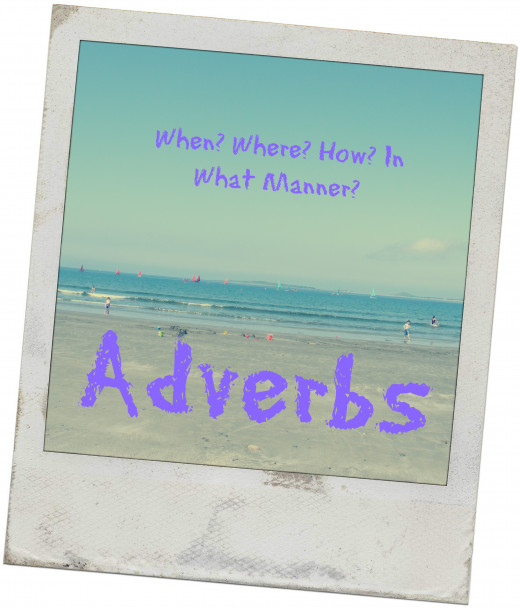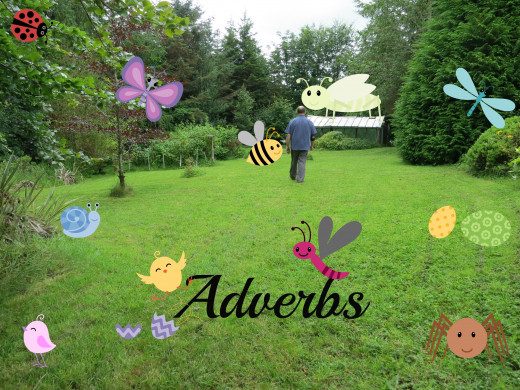Teaching Adverbs
Teaching Adverbs

What are adverbs?
Luckily, Now, A lot, Possibly and Hardly Ever are all adverbs. Looking at those four words, do you find it difficult to see the connection between them? Well, don’t worry if you find it confusing, you wouldn’t be the first!
The easiest way to understand them is to think of them as categories of words that tell us how, why, when or under what conditions something happened.
Adjectives modify nouns and adverbs modify pretty much everything else! They are separated into adverbs of manner, time, place, frequency, quantity, attitude and degree.
That’s why they all look different and can be found in various positions in a sentence. This article looks at the different types of adverbs and gives clear and straightforward examples of each, which will hopefully (adverb!) give you a better understanding of them.
Adverbs of manner
They tell us how something is done, e.g. The students were shouting noisily, She treated him fairly.
Most adverbs of manner can be formed by adding ly to an adjective: Quick = Quickly. If the adjective ends in e, remove the e and add ly: Gentle = Gently. If the adjective ends in y, remove the y and add ily: Easy = Easily. If the adjective ends in ic, remove ic and add ally: Automatic = Automatically.
There are other exceptions that do not follow these rules:
Irregular Adverbs (ly rule)
Adjective
| Adverb
|
|---|---|
Hard
| Hard
|
Fast
| Fast
|
Straight
| Straight
|
Good
| Well
|
Difficult
| With difficulty
|
There are adjectives that end inly, but are not adverbs such as: friendly, cowardly, silly or manly. To use these as an adverb, you would say: They behaved in a silly manner/way.
There are other adverbs that look like they were formed using the ly rule above, but have a completely different meaning to the adjective, e.g. hardly and simply.
What are adverbs?

Adverbs of frequency
They tell us how often something is done, e.g. Always, often, sometimes, hardly ever, seldom, rarely, never.
Adverbs of definite frequency, e.g. Once or twice a day, Every Tuesday, Every 2 years.
You normally position the adverb of frequency before the main verb.
- She never cleans her room.
- We rarely see our grandparents.
Adverbs of definite frequency come at the end of a sentence.
- We take the dog to the vet every 6 months.
Usually, sometimes, often and occasionally can be placed at the very beginning of the whole clause.
- Usually he’s in a better mood.
Sometimes and often can also be positioned at the end of a clause.
- I don’t go to Mass often.
- I go to the graveyard sometimes.
The adverb of frequency goes after the verb To Be.
- He is seldom late.
- You are always in a good mood.
If there are 2 auxiliary verbs then the adverb goes between them.
- She should never have taken that money.
- It has always been developing in that manner.

Adverbs of Time
This expresses when something is done, e.g. Tomorrow, Yesterday, Today, Now, Then. These adverbs are usually found at the end of a clause.
- I’ll be there tomorrow
- We’ll see you then!
Adverbs of relative time: Soon, Afterwards, Just, Already, Still, Yet, Recently and Currently.
Afterwards and soon are normally placed at the end of a clause.
- He’s leaving soon.
- I’ll ring you afterwards.
Just is positioned before the main verb or between 2 auxiliary verbs.
- He left about an hour ago.
- We’ve just been talking about you.
Already and Still are placed before the main verb or at the end of a clause.
- They’ve packed already.
- We’re still waiting.
Yet goes at the end of a clause.
- Have you washed yet?
Recently and Currently can go at the end of a clause, before the main verb or between 2 auxiliaries.
- I went there recently.
- They are currently working on a solution.
Adverbs of Place
These tell us where something is done, e.g. Inside, Over there, Here.
Generally we place them at the end of a clause.
- Let’s go inside.
- I don’t like it here.
Adverbs of Degree
They tell us to what degree something is done.
- Hardly, Barely, Very.
Intensifiers make the adverbs and adjectives stronger.
- He’s extremely depressed today.
- I’m completely fed up.
Downtoners make the adverbs and adjectives weaker.
- She’s rather quiet.
- You’re fairly certain?
Adverbs of degree are placed before the adjective, adverb or main verb.
Adverbs of Quantity
How much something is done, e.g. Lots, not many, much. Normally we place these adverbs at the end of a clause.
- She thanked him a lot.
- They ate very little.

Focusing Adverbs
These adverbs draw attention to specific information e.g. Specifically, Especially, Particularly.
In addition, they illustrate some kind of a limitation – Only, Just, Purely.
They also refer to something already mentioned – Also, Too, Either.
The sentence position can vary for these adverbs, but they are usually placed just before the thing that they are qualifying.
- I love chocolate, especially white chocolate.
- There was no one else there, just him.
- I hate housework too.
Attitude Markers
These express the speaker’s attitude or opinion. Examples: Unfortunately, Seriously, Luckily, Clearly, Stupidly, Apparently, Frankly, Maybe, Definitely and Naturally.
They illustrate a speaker’s reaction to an event.
- Understandably, she doesn’t want to speak to me again.
They show how likely a situation is.
- He’ll probably be really angry.
They demonstrate a speaker’s opinion.
- Personally, I can’t stand that guy.
Attitude Markers are flexible and can be placed at the beginning of a sentence, before the main verb or after the first auxiliary.
Other Teaching Hubs
© 2013 Muttface








